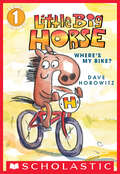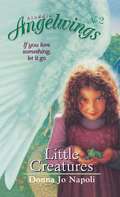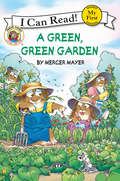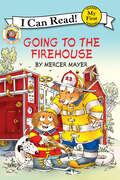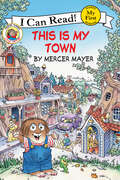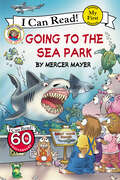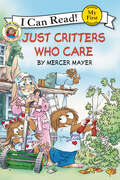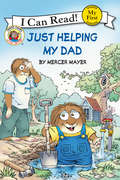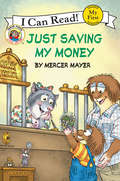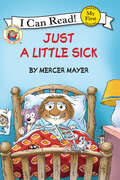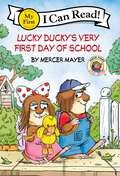- Table View
- List View
Literature: Timeless Voices, Timeless Themes (The American Experience, 7th Edition)
by Prentice HallThe textbook helps students grasp the power and beauty that lies within the written word, while the program's research-based reading approach ensures that no child is left behind.
Literature: Timeless Voices, Timeless Themes (The British Tradition)
by Prentice Hall12th Grade textbook on British literature.
Literature: Timeless Voices, Timeless Themes (The British Tradition) (Virginia Edition)
by Prentice HallBritish Literature High School textbook
Literature: Timeless Voices, Timeless Themes, Bronze, California Edition
by Kate KinsellaPrentice Hall Literature: Timeless Voices, Timeless Themes, was written to help build the pedagogical integrity of the program and to ensure its relevance for today's teachers and students.
Litmosphere - Functional Grammar & Communication in English Part-1 (Bilingual)
by Prof. M.A. Job"Functional Grammar & Communication in English (Part 1)" is a bilingual study aid tailored for first-semester students pursuing B.A., B.Sc., B.Com., BBA, and BCA degrees under Calicut University. Authored by Prof. M.A. Job, Part 1 focuses on literature, presenting diverse works spanning poetry, prose, and drama. Organized into four thematic modules—Literature Initiation, Creative Thinking and Writing, Critical Thinking, and Perspectives—it features pieces by notable authors such as Louis MacNeice, D.H. Lawrence, and Naguib Mahfouz. Each work is supported by bilingual explanations and exercises to deepen comprehension and foster critical analysis. Designed to enhance literary appreciation and examination readiness, this study aid serves as a vital resource for students navigating the foundational texts of their curriculum.
Litmosphere - Functional Grammar & Communication in English Part-2 (Bilingual)
by Prof. M.A. Job"Functional Grammar & Communication in English (Part 2)" is a bilingual study aid designed for first-semester students pursuing B.A., B.Sc., B.Com., BBA, and BCA degrees under Calicut University. Authored by Prof. M.A. Job, this part focuses on functional grammar and communication skills, offering practical tools to improve language proficiency and professional interaction. It covers essential topics like sentence structure, parts of speech, punctuation, and effective writing, alongside modules on verbal and non-verbal communication techniques. With bilingual explanations and exercises, it caters to diverse learner needs, helping students master the basics of grammar and communication critical for academic and career success.
Little Archie's Lucky Day
by Archie SuperstarsArchie Comics is proud to present our first picture book for little readers! This title follows the footsteps of great children's books like Corduroy and Where the Wild Things Are as being a modern classic for little ones to enjoy. Featuring full page illustrations and easy-to-read text from the masters of DC Comics' kids books.Archie's wildest day ever starts with a cat eating his homework - and things just get crazier from there! But this isn't just an ordinary cat, and this certainly won't be an ordinary day for Little Archie and his friends. Join in on the fun adventure from the superstar comics team Art Baltazar and Franco (Tiny Titans, Action Cat and Adventure Bug)!
Little Big Horse (Scholastic Reader Level 1 Ser.)
by Dave HorowitzA hilarious new easy reader from the author of THE UGLY PUMPKIN and DUCK, DUCK MOOSE.Little Big Horse is just a little guy, but he's got some big ideas about life. So when his friend Pablo borrows his bike without asking, and then accidentally breaks it, Little Big Horse has a lot to think about. Can these friends work it out?
Little Bird (Fountas & Pinnell Classroom, Guided Reading)
by Emma Levey Kate DopirakNIMAC-sourced textbook
Little Bird and the Bath (Into Reading, Level D #57)
by Eve Browne Melissa WebbNIMAC-sourced textbook
Little Creatures
by Donna Jo NapoliHow many feathers will it take? The Little Angel of Freedom can't wait till her wings are full of feathers. Then she'll hear a bell ring, and be able to fly. But to prove she's ready, she has to help out Simone, a little girl with a big problem. Simone likes to capture animals -- especially bugs. Sometimes they get harmed while they're in her care. The Little Angel has to use her powers to show Simone the right thing to do. But Little Angel's worried -- how will she rescue the captured animals? And will she ever get enough feathers to earn her Angelwings at last? Be kind to animals!
Little Critter: A Green, Green Garden (My First I Can Read)
by Mercer MayerJoin Mercer Mayer’s classic and beloved character, Little Critter® as he goes green in this My First I Can Read book!Little Critter learns that planting his own garden is a lot of fun and a lot of work. But the result—a green, green garden—is something he can cherish and enjoy.Little Critter: A Green, Green Garden is a My First I Can Read book, which means it’s perfect for shared reading with a child. Books at this level feature basic language, word repetition, and whimsical illustrations, ideal for sharing with emergent readers. The active, engaging stories have appealing plots and lovable characters, encouraging children to continue their reading journey.
Little Critter: Critters Who Care, Going To The Firehouse, This Is My Town, Going To The Sea Park, To The Rescue (My First I Can Read)
by Mercer MayerJoin Mercer Mayer’s classic and beloved character, Little Critter® as he visits the firehouse!Whoosh! goes the water hose. Ooo! Eee! Ooo! goes the siren. Ding! Ding! goes the fire alarm.Little Critter and his classmates are taking a trip to the firehouse! Little Critter puts on his boots and jacket—now he's ready to help Fireman Joe. After checking the hose and ladder, Little Critter is ready for a fireman's helmet of his own. Join Little Critter as he learns to stop, drop, and roll with Fireman Joe! Little Critter: Going to the Firehouse is a My First I Can Read book, which means it’s perfect for shared reading with a child.
Little Critter: Critters Who Care, Going To The Firehouse, This Is My Town, Going To The Sea Park, To The Rescue (My First I Can Read)
by Mercer MayerJoin Mercer Mayer’s classic and beloved character, Little Critter® as he shows young readers around his hometown.Welcome to Critterville!Little Critter® shares what he knows about his neighbors and the places to go in Critterville. Who delivers the mail? Where does Little Critter go to see a movie? Who keeps everyone safe? Come explore the town with Little Critter and discover where everyone works and plays!Little Critter: This Is My Town is a My First I Can Read book, which means it’s perfect for shared reading with a child.
Little Critter: Critters Who Care, Going To The Firehouse, This Is My Town, Going To The Sea Park, To The Rescue (My First I Can Read)
by Mercer MayerJoin Mercer Mayer’s classic and beloved character, Little Critter®, and his classmates for some underwater fun as they set out on a delightful trip to the sea park!With Little Critter and a charming world of sea creatures big and small, there’s a boatload of fun for everyone!Little Critter: Going to the Sea Park is a My First I Can Read book, which means it’s perfect for shared reading with a child. Books at this level feature basic language, word repetition, and whimsical illustrations, ideal for sharing with emergent readers. The active, engaging stories have appealing plots and lovable characters, encouraging children to continue their reading journey.
Little Critter: Just Critters Who Care (My First I Can Read)
by Mercer MayerWhen Little Critter finds out one of his neighbors is in need, he and his friends rally together and volunteer their help.They soon learn community service is rewarding . . . and fun! Who can the Critters help next?This is a funny and charming Little Critter story with a great message about caring about others.
Little Critter: Just Helping My Dad (My First I Can Read)
by Mercer MayerHonor dad on Father's Day or any day with this funny and touching story about Little Critter pitching in to "help" his dad.Mercer Mayer’s classic and beloved character, Little Critter, spends the whole day with his dad in this My First I Can Read book.From getting rid of a beehive to working in the yard and going to the store, Little Critter wants to be the world’s best helper. Things might not always go as planned, but that doesn't stop Little Critter from trying his hardest!Little Critter: Just Helping My Dad is a My First I Can Read book, which means it’s perfect for shared reading with young children..
Little Critter: Just Saving My Money (My First I Can Read)
by Mercer MayerJoin Mercer Mayer’s classic and beloved character, Little Critter® as he learns about it what it means to save money.Little Critter works hard for his money!When Little Critter wants a new skateboard, Dad tells him that he needs to save his own money to buy it! He tries his very best, but soon finds that saving enough for what he wants isn't so easy. Just Saving My Money is a My First I Can Read book, which means it’s perfect for shared reading with a child.
Little Critter: Just a Little Sick (My First I Can Read)
by Mercer MayerJoin Mercer Mayer’s classic and beloved character, Little Critter® in this My First I Can Read story.Little Critter has a day off from school! When Little Critter® feels just a little sick, Mom lets him stay home from school. Hooray! But between visiting the doctor and staying inside all day, missing school is not what Little Critter expected. Little Critter: Just a Little Sick is a My First I Can Read book, which means it’s perfect for shared reading with a child.
Little Critter: Lucky Ducky's Very First Day of School (My First I Can Read)
by Mercer MayerJoin Mercer Mayer’s beloved character Little Critter and Little Sister as they get ready for school in this My First I Can Read book! It’s the night before the first day of school and Little Sister is ready.Backpack—check!Pencils—check!Notebook—check!But wait, where is her favorite stuffed toy, Lucky Ducky? Little Critter helps out in this My First I Can Read story by beloved author-illustrator Mercer Mayer.Young readers will love the fun illustrations in Little Critter: Lucky Ducky’s Very First Day of School, and the simple text will resonate with new readers.This My First I Can Read book is carefully crafted using basic language, word repetition, sight words, and sweet illustrations, which means it's perfect for shared reading with emergent readers.


